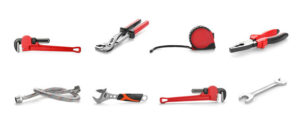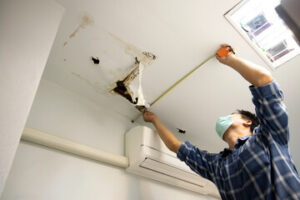A home or business fire can create devastating damage from flames, heat, smoke, and the water used to put out the fire. The process of restoring and repairing damaged areas requires several steps, including inspection, assessment, cleaning, sanitization, deodorization, and repair.
The inspection and assessment phase involves looking at structural damage, checking for more subtle impacts from the fire, and securing the property with board-up and tarping services. The next step includes water removal and drying.

Water Removal
If water was used to extinguish the fire, it will need to be removed from the property to prevent further damage. This step is often done by professionals using specialized equipment. Once the water is removed, the restoration team can proceed to assess and clean the property. They will use inspection checklists to determine what has been damaged by the fire, and which items are salvageable.
The next step is securing the property. This can include things like boarding up windows and doors, installing fencing around the site, removing debris and tarping or sealing parts of the roof to protect against weather. Depending on the severity of the fire, the property may also need to be completely cleared of debris and trees, or even demolished.
Cleanup is perhaps the most labor intensive part of a fire damage restoration project. The restoration team will use specialized cleaning agents to remove any remaining smoke and soot from all surfaces, including ceilings, walls, floors and furniture. Lingering odors will also be eliminated with the help of fogging machines and ozone or hydroxyl generators. This is a critical step that must be completed before any repairs can begin.
After cleaning, the professionals will dry all affected areas using fans and dehumidifiers. This will prevent mold from growing in the aftermath of the fire. Once the area is dry, the restoration team can move on to repairing and rebuilding any affected areas.
This is a critical step that must be performed as soon as possible. If the fire was severe, there is a good chance that the structure has been compromised and could collapse. Professionals will work to repair any structural damage and restore it as close as possible to its original condition.
Once the property has been cleaned and sanitized, it will need to be repainted or sealed. This is a standard part of any restoration process, and it will ensure that no lingering bacteria or contaminants remain in the home. It will also make the home much more aesthetically pleasing. If necessary, the restoration company can also assist with reconstruction services such as replacing drywall or carpet and remodeling.
Soot Removal
Soot is the oily residue that can stain surfaces and materials – not just the walls, but also carpeting, fabrics, and soft furnishings. Smoke char can also discolor finishes on kitchen appliances, tarnish metals, and create etching in glass. The greasy texture of soot also makes it difficult to clean without rubbing the stains in. A professional restoration service will use a high-efficiency particulate air (HEPA) vacuum to suck up loose soot and other debris and odors. They may also use a chemical solution made from warm water, chlorine bleach, and four to six tablespoons of tri-sodium phosphate to scrub the surface.
Once the fire damage has been assessed and deemed safe, the cleaning and sanitization process can begin. This step is typically the most intense and involves thorough cleaning of all affected areas. Any items that are not salvageable are removed and disposed of properly, and the ducts in the property will be cleaned.
This step usually starts with the removal of any debris that has accumulated in the property during the fire. Then, it is important to assess the fire damage for any structural issues that could lead to problems in the future. For example, if the roof was exposed to heat from the flames, it can be damaged by the hot temperatures and can cause leaks.
If the foundation of the property has been damaged, this can also be a problem. It is important to check the structure for cracks and crumbles before starting any repairs.
Another important step in this phase is determining the extent of any smoke and water damage to the contents of the property. This is done by examining the contents of each room to determine what can be saved and what will need to be replaced.
This stage is also the best time to dispose of any items that are beyond repair, as the longer these items remain in the house, the more difficult it will be to restore them. Once all items have been removed, the professionals will start repairing and restoring the property to its pre-loss condition.
Deodorization
If your home or business is experiencing fire damage, the restoration process will include deodorization. The deodorization process involves identifying and cleaning anything that has been affected by smoke or soot, including walls, furniture, ceilings, floors, and personal belongings. This can be a complicated task, depending on the severity of the fire damage.
During this step, professional technicians will clean any salvageable items, such as furniture and appliances. They will also inspect the structure of the building and identify areas that need further attention. This is particularly important for buildings with extensive fire damage. The extent of the damage can lead to a structural engineer being needed to assess the condition of the framing and foundation.
Smoke odors can linger long after the flames have gone out. If left unattended, these odors can penetrate surfaces and create an unpleasant environment. This can have a negative impact on the health and comfort of occupants, as well as the safety of anyone that enters the property.
To neutralize these odors, professionals will use air-conditioning units to create a controlled environment and remove odor particles from the air. This is an effective way to get rid of the smells associated with fire damage.
Another part of the deodorization process involves scrubbing and washing any fabrics that have been affected by the fire damage. This includes carpeting, drapes, and curtains. This helps to remove odors and protect the fabric from further damage. It’s also possible for stains to develop from the soot and other contaminants, which is why it’s important to have your home or business professionally cleaned after a fire.
The deodorization process is an essential part of restoring your home or business after a fire. Without it, lingering odors can become permanent and leave your property unlivable. In addition, the presence of smoke odor can indicate that there are other hidden issues in your property, such as hazardous chemicals or materials that have leached from the burned building materials. These chemicals can pose a threat to the health of your family or employees, and it’s important that they’re identified and removed before the building is considered safe for occupancy.
Repairs
When a fire destroys your home or business, it can leave behind more damage than just smoke and water. Structural concerns and other problems may need to be addressed in order to restore the property to its original condition. This includes replacing joists, beams, and other structural components. The repair process can also include repairing and painting the exterior of the building, as well as remodeling, carpentry, and construction work to rebuild the affected areas of the property.
The repair process is often a long and tedious task. It can involve everything from removing and cleaning contaminated items to refinishing wood surfaces to remove the odor of smoke. In some cases, the restoration company will need to re-paint the affected areas and replace carpeting and other materials. They will also need to repair any damaged electrical systems, drywall, and flooring.
During the restoration process, it is important to limit foot traffic in the affected area as much as possible. This can help prevent the spread of soot and other contaminants throughout the house. It is also a good idea to use industrial fans to circulate air and push out any remaining odors. It is also a good idea to water houseplants with fresh water to help eliminate any dirt that may have gotten on the leaves from dust and soot.
One of the most important things to do is to document all the damage with photos. This will allow you to keep track of all the restoration processes and get an idea of how quickly the fire damage can be repaired. It is a good idea to take pictures of all the affected areas, including inside closets, drawers, and cabinets. It is also a good idea to document any damaged items, such as clothing and furniture.
If your home or business has been damaged by a fire, you need to call a restoration company immediately. A qualified restoration company can address any fire damage restoration needs that you have, and they will also be able to guide you through the insurance claims process.








